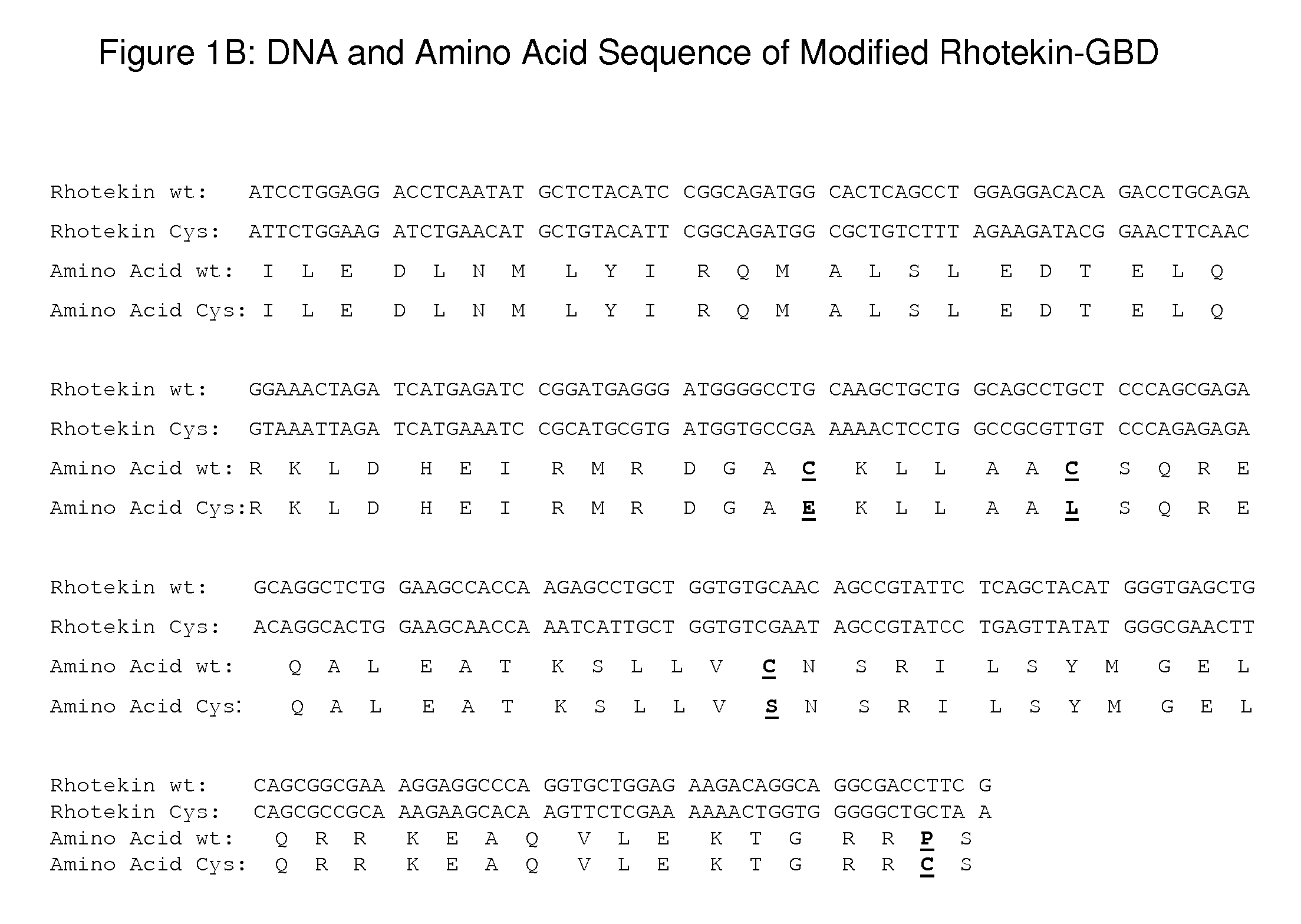Detection of Rho proteins
a technology of rho proteins and detection methods, applied in the field of detection of rho proteins, can solve the problems of poor reproducibility of assays, low sensitivity, and inability to meet high throughput applications
- Summary
- Abstract
- Description
- Claims
- Application Information
AI Technical Summary
Benefits of technology
Problems solved by technology
Method used
Image
Examples
example 1
Production of Effector-GBD Peptides for the G-LISA Assay
[0104]There are some sequence motifs that are shared between subgroups of Rho GTPase effectors, for example, the Cdc42 / Rac-interacting binding (CRIB) motif is present in many, though not all Rac and Cdc42 binding proteins (Burbelo et al., 1995, J. Biol. Chem., 270:29071-29074) and has been found to be necessary but not sufficient for effector binding (Rudolph et al., 1998, J. Biol. Chem., 273:18067-18076). A further common Rho effector motif is the Rho effector homology (REM) found in PRK1 and PRK2 and the HR1 repeat motif which is found in effectors such as rhophilin and rhotekin (Flynn et al., 1998, J. Biol. Chem., 273:2698-2705). However, there are a large number of effectors that do not contain any of the currently identified GTPase-binding motif / s. These include the POSH, PI3K and DAG effectors (Bishop et al., 2000, Biochem. J., 348:241-255). This type of protein is classified as a Rho effector purely on its functional abi...
example 2
Utility of Covalently Linked Effector-GBD Plates in G-LISA Assays
[0127]There are many chemistries described in the art for linking a particular peptide to a microtiter plate or microarray (Dent et al., 1998, Bioconjugation, Macmillan Reference Ltd, Chapter 8:505-556). In the broadest terms, linkages can be classified into covalent and non-covalent formats. Both types of linkage are demonstrated herein (see non-covalent linkage, Example 7). The example described herein details a method of covalent linkage through maleimide activated plates.
[0128]Covalent linkage of peptides to microtiter plates through activated surface groups occurs when electrons are shared between atoms to generate chemical bonds. While the reactions forming such bonds are always theoretically reversible, the low probability of the reverse reaction occurring in practice results in products that can be thought of as permanent (Dent et al., Bioconjugation, Macmillan Reference Ltd, 1998, p. 218-342). The essentially ...
example 3
Development of Antigen Presenting Buffer for the G-LISA
[0147]Initial attempts to detect active Rho GTPases in the RhoA:ROCK and Rac1:POSH G-LISA assays were not successful because a signal that was significantly above background in either assays (FIGS. 5A (untreated) and 5B (no APB)) could not be obtained. An initial strategy was to develop an ELISA based assay by following a protocol essentially analogous to the original pull-down assays described by Benard et al. for the Rac1:PAK pull-down assay (1999, J. Biol. Chem., 274:13198-13204) and Ren et al. and Kranenburg at al. for the RhoA:Rhotekin pull-down assay (1999, EMBO J., 18:578; and 1999, Mol. Biol. Cell, 10:1851-1857, respectively). The same procedure has been used for pull-down assays using ROCK, Citron, Dia and WASP (Kimura et al., 2000, J. Biol. Chem., 275:17233-17236, and Edlund et al., 2002, Mol. Biol. Cell, 13:902-914). Briefly, maleimide plates were coated with effector, active Rho GTPases in standard pull-down lysis bu...
PUM
| Property | Measurement | Unit |
|---|---|---|
| pH | aaaaa | aaaaa |
| pH | aaaaa | aaaaa |
| concentration | aaaaa | aaaaa |
Abstract
Description
Claims
Application Information
 Login to View More
Login to View More - R&D
- Intellectual Property
- Life Sciences
- Materials
- Tech Scout
- Unparalleled Data Quality
- Higher Quality Content
- 60% Fewer Hallucinations
Browse by: Latest US Patents, China's latest patents, Technical Efficacy Thesaurus, Application Domain, Technology Topic, Popular Technical Reports.
© 2025 PatSnap. All rights reserved.Legal|Privacy policy|Modern Slavery Act Transparency Statement|Sitemap|About US| Contact US: help@patsnap.com



